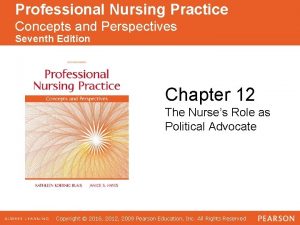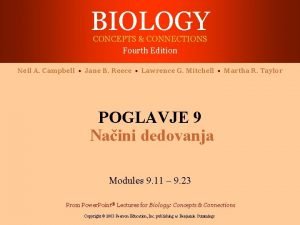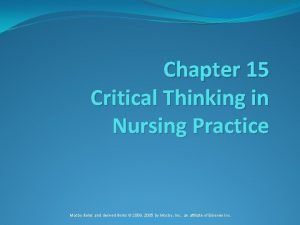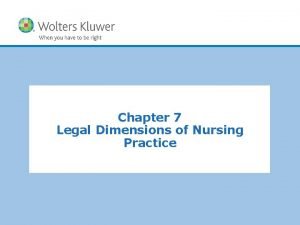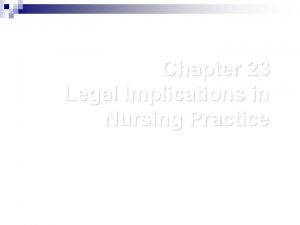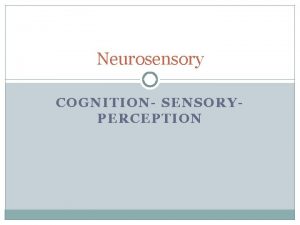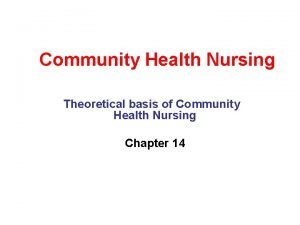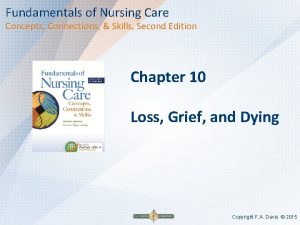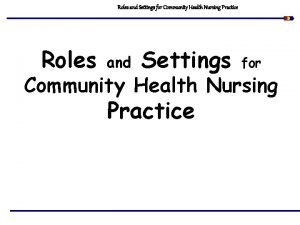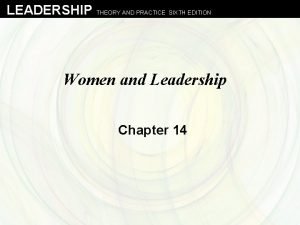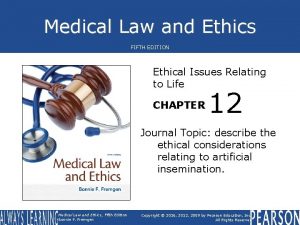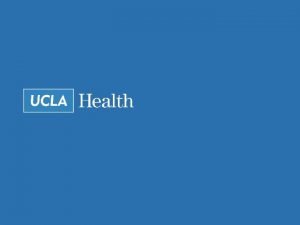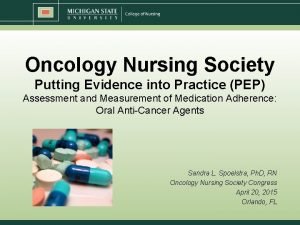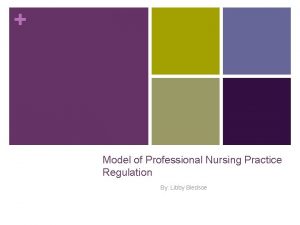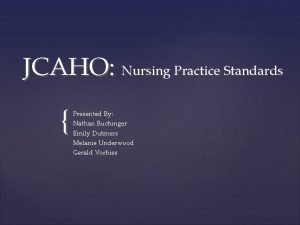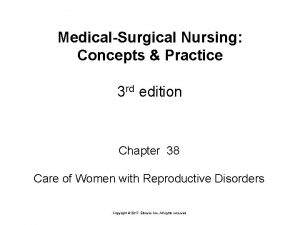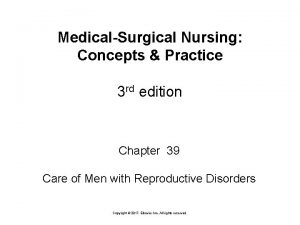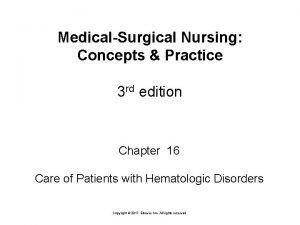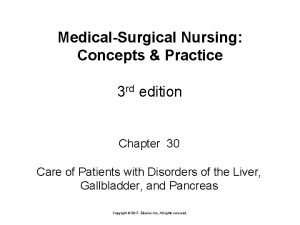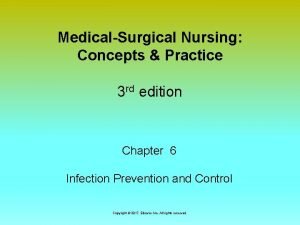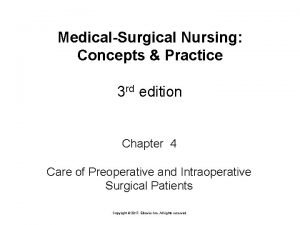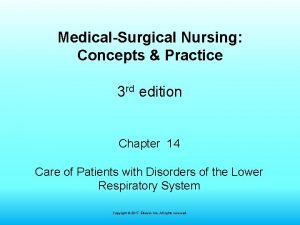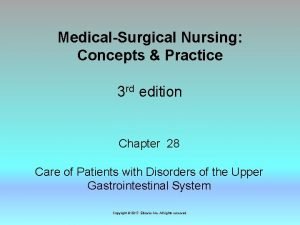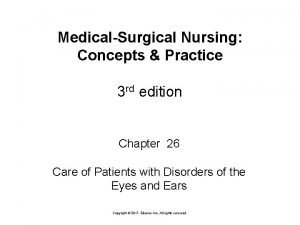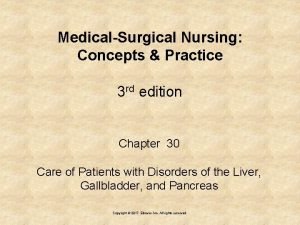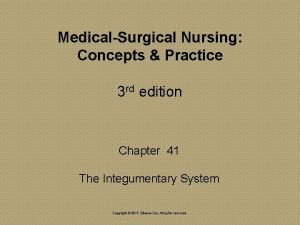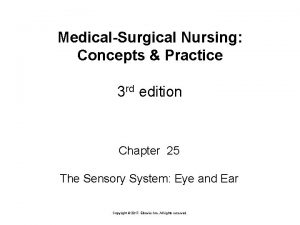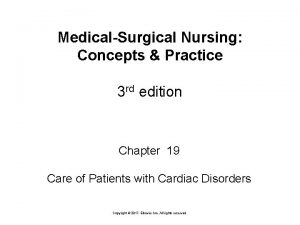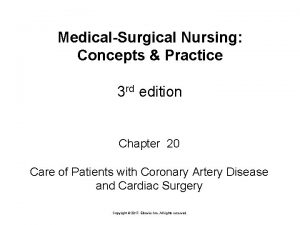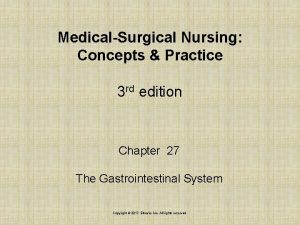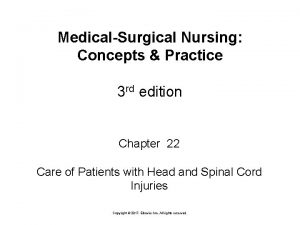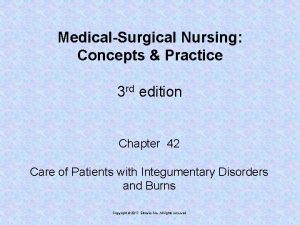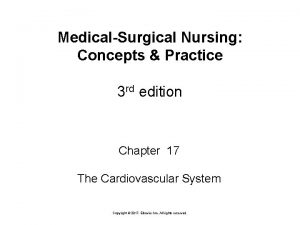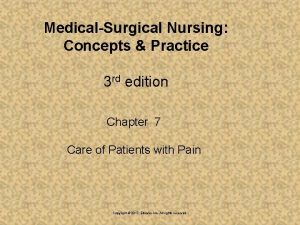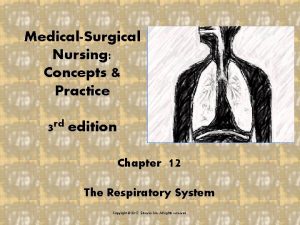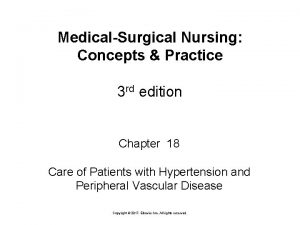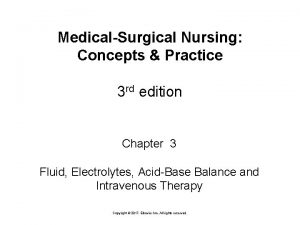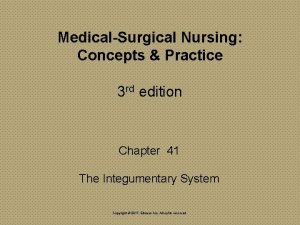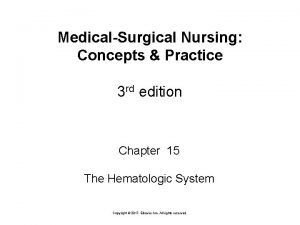MedicalSurgical Nursing Concepts Practice 3 rd edition Chapter



























- Slides: 27

Medical-Surgical Nursing: Concepts & Practice 3 rd edition Chapter 31 The Musculoskeletal System Copyright © 2017, Elsevier Inc. All rights reserved.

Theory Objectives Describe the normal anatomy of the musculoskeletal system. Show the musculoskeletal system provides the function of motion. Discuss how the musculoskeletal system provides protection for the body. Copyright © 2017, Elsevier Inc. All rights reserved. 2

Theory Objectives (Cont. ) Illustrate causes of disorders of the musculoskeletal system and ways to prevent them. Compare the procedure and nursing care for the following diagnostic tests: bone scan, arthroscopy, and electromyography. Distinguish ways in which older adults can increase musculoskeletal strength and protect their bones. Copyright © 2017, Elsevier Inc. All rights reserved. 3

Clinical Practice Objectives Perform an assessment on a patient with a musculoskeletal disorder. Assist in the development of a nursing care plan for a patient with a musculoskeletal disorder. Use measures to reduce the chance of contracture for patients with musculoskeletal injuries. Copyright © 2017, Elsevier Inc. All rights reserved. 4

Clinical Practice Objectives (Cont. ) Assist patients with musculoskeletal injuries with active or passive range of motion. Provide care for a patient who has undergone magnetic resonance imaging with contrast. Teach a patient to properly use an assistive device. Copyright © 2017, Elsevier Inc. All rights reserved. 5

Overview Structure and functions of bones Structure and functions of muscles Age-related changes Copyright © 2017, Elsevier Inc. All rights reserved. 6

Major Bones of the Human Skeleton Copyright © 2017, Elsevier Inc. All rights reserved. 7

General Features of Long Bones From Lewis SL, Heitkemper MM, Dirksen SR, et al: Medicalsurgical nursing: assessment and management of clinical problems, ed. 9, St. Louis, 2014, Mosby. Copyright © 2017, Elsevier Inc. All rights reserved. 8

Causes of Musculoskeletal Disorders Trauma and bruising, strain, sprain, or fracture Poor nutrition and weak bones Inadequate protein and muscle wasting Malignant tumors Estrogen and osteoporosis Copyright © 2017, Elsevier Inc. All rights reserved. 9

Prevention Weight training Safety measures Nutrition for bone growth and density Smoking and musculoskeletal health Copyright © 2017, Elsevier Inc. All rights reserved. 10

Diagnostic Tests and Procedures Blood counts Blood cultures Immune tests Erythrocyte sedimentation rate (ESR) Serum protein electrophoresis Serum complement and immunoglobulins Copyright © 2017, Elsevier Inc. All rights reserved. 11

Diagnostic Tests and Procedures (Cont. ) Imaging and use of contrasts Ø Nursing management Goniometry and range of motion Copyright © 2017, Elsevier Inc. All rights reserved. 12

Measurement of Joint Motion with a Goniometer From Mourad LA: Orthopedic disorders, St. Louis, 1991, Mosby. Copyright © 2017, Elsevier Inc. All rights reserved. 13

Assessment (Data Collection) Note problems of movement and changes in facial expression related to activities of daily living (ADLs). Precipitating events Family members’ and patient’s ability to perform the ADLs Copyright © 2017, Elsevier Inc. All rights reserved. 14

Physical Assessment of the Musculoskeletal System Posture, gait, and balance Mobility, range of motion, and strength Spine Appearance of joints Skeletal muscle appearance in arms and legs Ability to perform ADLs Older adult considerations Copyright © 2017, Elsevier Inc. All rights reserved. 15

Nursing Diagnosis and Planning Requires careful planning Ø Ø Making beds Planning for toileting Copyright © 2017, Elsevier Inc. All rights reserved. 16

Lifting and Turning the Patient Gentle and firm movements Sufficient help and adequately trained personnel If the patient can help without damaging the diseased joint or limb, he or she should be encouraged to do so. If the patient is not able to help, explain the procedure to the patient and instruct him or her to relax completely during the procedure. Copyright © 2017, Elsevier Inc. All rights reserved. 17

Interventions to Prevent Disability Gradual mobilization Exercise program Proper positioning Patient and family teaching Nursing responsibility Ø Initiate and maintain measures to prevent complications. Copyright © 2017, Elsevier Inc. All rights reserved. 18

Interventions to Prevent Disability (Cont. ) Prevent contractures. Ø Ø “Adaptive shortening” Most common: “footdrop, ” knee and hip flexion contractures, “wrist drop, ” and contractures of the fingers and arms Loss of muscle tone Copyright © 2017, Elsevier Inc. All rights reserved. 19

Interventions to Prevent Disability (Cont. ) Copyright © 2017, Elsevier Inc. All rights reserved. 20

Interventions to Prevent Disability (Cont. ) Prevent ankylosis. Gradual mobilization Ø Ø Nursing responsibility: Recognize patients who are at risk for falls while they are learning to regain their mobility. Set goals for progressive mobilization. Copyright © 2017, Elsevier Inc. All rights reserved. 21

Interventions to Prevent Disability (Cont. ) Exercise and ROM exercises Ø Ø Ø Isometric exercises Administration of analgesic and anti-inflammatory drugs Continuous passive motion Positioning and special beds Copyright © 2017, Elsevier Inc. All rights reserved. 22

Interventions to Prevent Disability (Cont. ) Use of slings and splints Teaching ambulation with assistive devices Ø Ø Crutch safety Special maneuvers on crutches Psychosocial care Copyright © 2017, Elsevier Inc. All rights reserved. 23

Continuous Passive Motion Machine Copyright © 2017, Elsevier Inc. All rights reserved. 24

Fluid. Air Bed Copyright © 2017, Elsevier Inc. All rights reserved. 25

Wrist Splint Copyright © 2017, Elsevier Inc. All rights reserved. 26

Evaluation Determine the effectiveness of interventions. Be alert to nuances of body language. Observe the patient’s ability to accomplish ADLs. Check radiographs and laboratory tests. Collaborate among all health professionals. Copyright © 2017, Elsevier Inc. All rights reserved. 27
 Professional nursing practice concepts and perspectives
Professional nursing practice concepts and perspectives Professional nursing practice concepts and perspectives
Professional nursing practice concepts and perspectives Introduction to genetic analysis tenth edition
Introduction to genetic analysis tenth edition Operating system
Operating system Operating system concepts 6th edition
Operating system concepts 6th edition Database system concepts seventh edition
Database system concepts seventh edition Kariogram človeka
Kariogram človeka Mis chapter 6
Mis chapter 6 Chapter 1
Chapter 1 Fundamentals of nursing chapter 15 critical thinking
Fundamentals of nursing chapter 15 critical thinking Chapter 7 legal dimensions of nursing practice
Chapter 7 legal dimensions of nursing practice Chapter 23 legal implications in nursing practice
Chapter 23 legal implications in nursing practice Cost-benefit analysis concepts and practice
Cost-benefit analysis concepts and practice Interrelated concepts nursing
Interrelated concepts nursing Salmon white's construct for public health nursing
Salmon white's construct for public health nursing Fundamentals of nursing care concepts connections & skills
Fundamentals of nursing care concepts connections & skills Role of community health nurses
Role of community health nurses Leadership theory and practice 6th edition
Leadership theory and practice 6th edition Computer security principles and practice
Computer security principles and practice Modern real estate practice in pennsylvania 14th edition
Modern real estate practice in pennsylvania 14th edition Ethical problems in the practice of law 5th edition
Ethical problems in the practice of law 5th edition Computer security principles and practice 4th edition
Computer security principles and practice 4th edition Joey's first 14 quiz grades in a marking period were
Joey's first 14 quiz grades in a marking period were Myeplg
Myeplg Unit practice council nursing ideas
Unit practice council nursing ideas Putting evidence into nursing practice
Putting evidence into nursing practice Model of professional nursing practice regulation
Model of professional nursing practice regulation Joint commission impact on nursing practice
Joint commission impact on nursing practice

